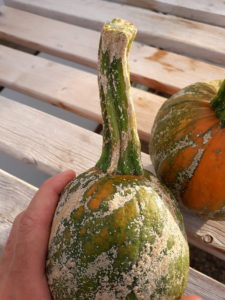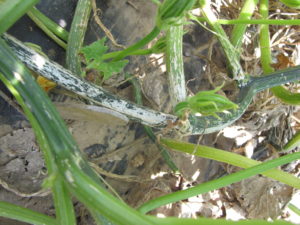Recently, I have had a few phone calls about Plectosporium blight on pumpkins. This disease can be difficult to describe in words. However, once observed, Plectosporium blight is easy to remember. Therefore, this article will include photos of the disease.
Lesions of Plectosporium blight are most often observed on the stems of affected plants. The lesions are small and irregularly shaped. The lesions often coalesce to form a scabby area (Figure 1 and 2). When the handle of the pumpkin is affected, the marketability of the pumpkin is affected. In severe cases, the pumpkin itself may have lesions of Plectosporium blight.
Plectosporium blight lesions on fruit may be confused with bacterial spot. However, bacterial spot lesions are usually larger than Plectosporium blight lesions and do not coalesce over large areas like Plectosporium blight.
This disease may be managed through a combination of cultural and fungicide treatments. Crop rotations of 3-4 years and fall tillage will help keep the crop residue to a minimum. A regular contact fungicide program will also help to keep Plectosporium blight in check. This fungicide schedule purdue.ag/pumpkinfs for pumpkins lists the systemic fungicides Cabrio®, Inspire Super®, Merivon® and Quadris®/Satori®.

